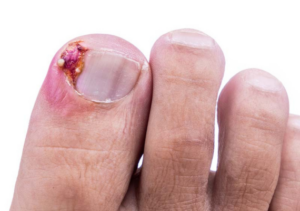An ingrown toenail, medically known as onychocryptosis, occurs when the edge or corner of a toenail grows into the surrounding skin, causing pain, redness, swelling, and sometimes infection. This common condition primarily affects the big toe.
Causes of Ingrown Toenails
- Improper Nail Trimming: Cutting nails too short or rounding the edges encourages the nail to grow into the skin.
- Tight Footwear: Shoes that are too tight or narrow can press the nail into the skin.
- Injury: Trauma to the toe, such as stubbing or dropping something heavy on it.
- Genetics: Naturally curved nails that are more prone to becoming ingrown.
- Poor Foot Hygiene: Not keeping feet clean and dry increases the risk.
- Foot Structure: Conditions like flat feet, bunions, or excessive pronation.

